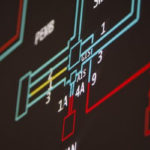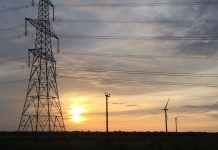 Two generators tripping caused the biggest frequency drop for years, with widespread power outages as National Grid’s systems disconnected demand in order to limit the impact.
Two generators tripping caused the biggest frequency drop for years, with widespread power outages as National Grid’s systems disconnected demand in order to limit the impact.
RWE’s 740MW Little Barford gas-fired power station reported that it had tripped first, followed by some units at Ørsted’s Hornsea offshore wind farm.
Strong winds led to exceptional volumes of renewable power on the system, and fewer thermal plant generating as a result. That reduced inertia on the system, reducing the available resources to manage the outages as frequency quickly dropped to 48.9hz – well below tolerance boundaries.
National Grid ESO said it took action to cut demand in some areas to protect the rest of the system. That led to outages across the country. The system operator said all areas were restored by 18:30, though transport networks and commuters were feeling the effects for the rest of the evening.
National Grid has to maintain the power system close to 50hz to keep it stable. In the past, it has relied on inertia in the system in order to regulate frequency.
However, inertia has been provided by the large spinning turbines of big power stations. As coal plant shuts down and gas load factors reduce as more wind and solar comes on stream, there is less available inertia.
National Grid is therefore more reliant on ‘synthetic inertia’ provided by companies responding very quickly using batteries, or turning large plant on or off, or fast acting forms of generation such as pumped storage, to balance frequency.
It pays companies to deliver frequency response – which usually helps to prevent large-scale outages.
National Grid aims to be able to operate the system entirely on renewable sources when practicable by 2025 and will therefore require greater sources of flexibility to keep the system balanced.
The incident will also have given businesses and critical infrastructure providers – such as hospitals, banks, airports and data centres – a clearer picture of the state of their back-up power systems.
Interested in demand-side response? National Grid, energy suppliers, aggregators, distribution networks and consultants will outline the direction of travel at The Energyst’s DSR Event, 11 September, London. Details here.
Related stories:
Take our DSR and battery storage survey
Reactive Technologies signs deal with ESO to measure inertia
National Grid uses more Stor and frequency response, flags challenges ahead
National Grid and Epex Spot to collaborate on weekly FFR auction
National Grid to trial same day FFR auction
Grid to bring wind and solar into FFR, details balancing system overhaul
Can the Balancing Mechanism offset FFR price erosion?
Grid outlines plans to bring all flex providers into Balancing Mechanism
Grid outlines plans for hundreds of millions worth of services
Grid plots major overhaul of balancing services with frequency response first to change
National Grid mulls rolling all frequency response services into one
Faraday Grid: We come from the future to stabilise the power system
Click here to see if you qualify for a free subscription to the print magazine, or to renew.
Follow us at @EnergystMedia. For regular bulletins, sign up for the free newsletter.




Absolutely ridiculous the spinning reserve has been taken out of the mix. We will always be dependent upon Coal and Nuclear, whether or not the climate change terrorists and politicians having their pockets lined by the corrupt renewables industry like it or not.
Pleased to see reference to the inertia of large-mass generators and their importance to maintaining system stability and reliability. It will be most interesting to experience the future of ‘synthetic inertia’.
Will the ‘synthetic’ inertia be any more realistic than the syntheic climate projections prompting this race to renewables.
https://external-preview.redd.it/hUMsBE0Qfqwv4xQaTjlw9hknod0eQla9duqyqRzL84g.jpg?width=960&crop=smart&auto=webp&s=53a934435b20a8e1bd722ab2d574365d4c8209eb
Likely much the same.
Synthetic Inertia will be Eskom v2.0! (Eskom / Escom is the once fantastic South African power utility. It’s been run into the ground by affirmative action, sheer incompetence, corruption and political interference). Of around 48GW installed capacity, sometimes as little as 22GW functional. I remember in the ’70s, they gave consumers a subsidy to go out and buy fridges and electric heaters, there was so much spare capacity available. I digress, apologies!
Sounds like a failure of the frequency response protection system. Not enough flexible generation or demand available….
Is there any connection to the current suspension of the capacity market..?
(Politically sensitive as it’s related to EU legislation of course)
This event is a clear demonstration that the (suspended) capacity market is irrelevant to reliability in such circumstances. There was tens of GW of idle capacity which would all have been eligible for the capacity payments despite being unable to respond to the problem: the terms of the capacity market are that plants must be able to respond within 4 hours!! In any actual blackout the issue will result from a failure of some sort with zero notice, so the (suspended) capacity market is not targeting the flexibility which the system really needs. Generation capacity is an option to deliver energy: the value of options depends on the degree of flexibility and separately the activation price. We need a capacity trading mechanism based on the real economics of the energy system of today and the future, not the past.
I am sure the mains frequency is measured in Hz , not gHz as mentioned in the article
I think you were misled by the information submitted to the Grid by Hornsea wind farm on when it shut down . They claimed that happened at precisely 16:00:00 GMT, but didn’t even submit that report for another 20 minutes. By then everything had all happened. The major fall in grid frequency started at 15:52:32 GMT, and by the combination of load shedding and additional generation frequency was back over 50Hz by 15:58 GMT. You can see that here:
https://twitter.com/upsideenergy/status/1159870347618865152
Perhaps they wanted to avoid the blame. It looks as though they probably lost the transmission line to shore or maybe the connection transformers at one end or other. The steepness of the loss of frequency is the clue.
Considering the impact the event caused and the numbers of people effected I am surprised that as of the 11th there are no comments on this event.
Drax Electrical insights shows a demand of 33GW in the hour before the event.
The generation lost amounts to around 3%.
“Small” loss, big impact.
Looks like a lot more storage need PDQ
The fact is the Grid failed to have sufficient frequency response available, and that may be because their procurement process has cut FR fees to the bone. You can’t ‘nickle & dime’ system resilience
If we assume that 2.5C discharge rate is feasible from ex-EV batteries, then to cover an event of 2GW some 800MWh of batteries are needed; that’s um 20,000 ex EV batteries if each can burst deliver as if a useful 40kWh unit. They would be flat after 20mins; let’s suggest they were 1/2 charged so 10mins.
Sorting extra real generation out in that time sounds very possible. Such a battery reserve is completely doable and within the next 5 years too, I’d expect.
But, this would be a giant. What impact would this bad boy have on the markets? Time to run away from this sector, as such kit will dominate.
SteveB
sr.broderick @ zoho.eu
With combination of renewable with conventional gas or thermal units in conjunction you will always have a stability problem and solution is not found so far.
National Grid made a series of errors and were responsible for the extent of the impact – not the least why cut power to transport at their peak demand time. I’m a bit confused about the inertia argument as another article (https://energystst.wpengine.com/national-grid-blackouts-lcp-analysis/) shows a chart of inertia, which was well above NG’s suggested ‘limits’ and hardly changed during the whole event. While two plant coming off-line almost simultaneously might be rare, the total generation loss wasn’t particularly high. Also, surely their processes should expect a second failure immediately as not only could a drop in frequency cause a disconnection elsewhere, the impact would be proportionately worse, so should have been modeled and NG should have been ready for it. Heads should roll and NG’s position of ultimate power should be reviewed.